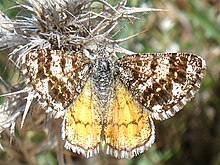Banded broom spanner
| Banded broom spanner | ||||||||||||
|---|---|---|---|---|---|---|---|---|---|---|---|---|

Banded broom spanner ( Isturgia famula ), |
||||||||||||
| Systematics | ||||||||||||
|
||||||||||||
| Scientific name | ||||||||||||
| Isturgia famula | ||||||||||||
| ( Esper , 1787) |
The Banded broom tensioner ( Isturgia famula , Syn. : Bichroma famula ) is a butterfly from the family of the tensioner (Geometridae). The species name is derived from the Latin word famula meaning “maid” and was apparently chosen arbitrarily.
features
butterfly
The wingspan of the moth is 24 to 28 millimeters. The basic color of the upper forewings varies in both sexes from whitish to light yellow and shows a dark brown marbling, which is sometimes so pronounced that only small light areas remain and the transverse lines are covered. On the pale yellow to orange-yellow upper side of the hind wing three dark brown transverse lines stand out. The undersides of the forewings are yellow-gray to rust-brown in color and show a series of large black-brown spots in the submarginal region . The white-gray underside of the hind wing is very brownish marbled, so that the transverse and longitudinal lines hardly stand out.
Caterpillar
Adult caterpillars are elongated and green in color, with a black-brown back line that is lined with whitish contrasts. A wide, white-yellow side stripe, which is lined with black, is characteristic.
Similar species
The butterflies are unmistakable due to the distinctive wing pattern.
distribution and habitat
The distribution area of the banded broom spanner stretches from northwest Africa across the Iberian Peninsula to eastern Germany. The species is absent in north and south-east Europe . The most easterly deposit is in Brandenburg , where the first record was made in 1937. After that, the species was not detected there for a long time and only reappeared in numbers 60 years later on a military training area. In general, the occurrences in Germany have the character of an island, since the species prefers to colonize the warmest dry gorse heaths. There are stable populations in Rhineland-Palatinate and Hesse . In Baden-Württemberg and Thuringia , the species is considered to be extinct or lost.
Way of life
The moths fly in one generation from early May to late June. They are exclusively diurnal and fly in stormy zigzag flight low over the vegetation in the sunshine. An artificial light sources do not appear. The females lay more than 200 very small eggs, which are laid individually or in groups on leaves, twigs, cracks, branches or leaf bases of the food plant. The caterpillars feed mainly on the leaves of broom broom ( Cytisus scoparius ). Other types of gorse were also accepted as food in breeding. The species overwinters as a pupa under moss on the ground or in the ground. When breeding, the pupae sometimes survive for several years.
Individual evidence
- ^ Arnold Spuler: The butterflies of Europe , Volume 2, E. Schweizerbart'sche Verlagsbuchhandlung, Stuttgart, 1910, p. 113
- ↑ Walter Forster , Theodor A. Wohlfahrt : The butterflies of Central Europe. Volume 5: Spanner. (Geometridae). Franckh'sche Verlagshandlung, Stuttgart 1981, ISBN 3-440-04951-5 , pp. 225/226
- ^ Günter Ebert (Ed.): The butterflies of Baden-Württemberg. 1st edition. Volume 9. Moths VII. Geometridae 2 Ulmer, Stuttgart (Hohenheim), 2003, ISBN 3-8001-3279-6 , pp. 342-346
- ↑ dissemination
- ^ Karl Stöckel: Die Großschmetterlinge der Mark Brandenburg , unpublished manuscript in the Stadtmuseum Berlin, 1184 p., 1955
- ↑ a b c d Ingolf Rödel & Robert Trusch: On the biology, ecology and distribution of Bichroma famula (ESPER, 1787) in Germany (Lepidoptera, Geometridae) , Entomological News and Reports 41 (1), Dresden, 1997, p. 19– 26th
literature
- Arno Bergmann : The large butterflies of Central Germany. Volume 5/2: Spanner. Distribution, forms and communities. Urania-Verlag, Jena 1955, DNB 450378411 .
- Manfred Koch , Wolfgang Heinicke, Bernd Müller: We determine butterflies. Volume 4: Spanner. 2nd, improved and enlarged edition. Neumann, Leipzig / Radebeul 1976, DNB 780451570
- Günter Ebert (Ed.): The butterflies of Baden-Württemberg. 1st edition. Volume 9. Moths VII. Geometridae 2 Ulmer, Stuttgart (Hohenheim), 2003, ISBN 3-8001-3279-6
Web links
- Lepiforum e. V. - Taxonomy and photos
- fauna-eu - Fauna Europaea


